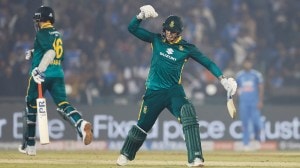The story itself was deceptively simple. Oliver Barrett IV, a Harvard hockey player and heir to a banking dynasty, falls for Jennifer Cavilleri, a sharp, working-class Radcliffe music student. Their romance crosses lines of class and expectation, and they marry against Oliver’s father’s wishes. Just as they begin to build a life together, Jenny is diagnosed with leukemia. The novel ends with her death and Oliver’s grief distilled into one immortal line: “Love means never having to say you’re sorry.”

For a generation facing the uncertainties of the Vietnam War and the disillusionments of the late 1960s, Love Story became both a balm and a cultural shorthand for young love shadowed by tragedy.
Enter Bollywood’s Saiyaara
Fast forward to July 2025. Mohit Suri’s Saiyaara stormed Indian cinemas before landing on Netflix this September. Starring debutants Ahaan Panday and Aneet Padda, the film has already become the highest-grossing Hindi romance of the year, a remarkable feat in an era where most debuts vanish quietly.
Its premise, much like Segal’s novel, is straightforward but piercing. Krish, a hot-headed aspiring musician, finds an unlikely soulmate in Vaani, a writer still reeling from betrayal by her ex-fiancé. Their bond deepens through art and shared wounds, but just as they settle into a life together, Vaani begins to show signs of early-onset Alzheimer’s.
If Segal’s lovers are robbed of time by death, Suri’s are robbed of memory. In both cases, love becomes an act of endurance against forces far beyond human control.
Illness as destiny
 Ryan O’Neal and Ali MacGraw starred in Love Story, a romance that defined a generation and introduced the immortal line: “Love means never having to say you’re sorry. ” (Wikimedia Commons)
Ryan O’Neal and Ali MacGraw starred in Love Story, a romance that defined a generation and introduced the immortal line: “Love means never having to say you’re sorry. ” (Wikimedia Commons)
The resonance between the two stories lies not only in their structures but in their chosen metaphors for love’s fragility. In 1970, Jenny’s leukemia was the looming shadow. In 2025, Vaani’s Alzheimer’s feels like a modern dread: a gradual erasure of identity itself, a slow-motion unmaking of intimacy.
Story continues below this ad
Both illnesses serve the same narrative purpose. They ask what remains when romance is stripped of its promise of longevity. Can love still matter if it is brief, if it is cut short, if it is remembered by only one?
For Oliver, the answer comes in the form of a line passed into cultural memory. For Krish, it comes in the form of a song, “Saiyaara,” a musical farewell that turns private grief into something enduring.
Love Story was adapted into a film the same year the novel was published, with Ali MacGraw and Ryan O’Neal in the lead roles and a soundtrack that became a classic. It soon inspired unofficial remakes across the world. In Bollywood, it influenced the 1978 Sachin–Ranjeeta starrer Ankhiyon Ke Jharokhon Se; in Malayalam cinema, Madanolsavam starring Kamal Haasan and Zarina Wahab; and in Tamil, Ninaithale Inikkum, which had a loosely similar central plot with the lead singer of a music band falling in love with a woman who dies of leukemia.
Music, memory, and the universal chord
If Love Story gave us one unforgettable phrase, Saiyaara gives us a soundtrack. The film’s music, composed by Mithoon, Vishal Mishra, and Sachet-Parampara, carries the emotional arc of the story. Songs are not decoration but lifelines: Krish and Vaani’s love is stitched into melodies, so that when memory fails, the music remains.
Story continues below this ad
This is a familiar Suri signature, his films from Aashiqui 2 to Ek Villain have leaned heavily on music to amplify emotion. Where Segal’s prose distilled heartbreak into words, Suri’s film translates it into refrain and rhythm, making melody a vessel for memory.
Why we keep returning to doomed romance
It would be easy to dismiss both stories as melodrama. Critics did exactly that with Love Story, and some have leveled similar charges at Saiyaara. Yet their commercial success, across eras, across continents, suggests something else.
Audiences may crave catharsis as much as they crave happy endings. Doomed romances reassure us not that love conquers all, but that love matters even when it cannot conquer fate. These stories devastate, yes, but they also console: to love at all, even briefly, is to have lived more fully than to never love at all.
Half a century apart, the same heartbeat
To read Segal after watching Suri is to glimpse the DNA of the modern screen romance: boy meets girl, class or circumstance intervenes, illness intrudes, grief transforms. To watch Saiyaara after reading Segal is to see how enduring that template remains, dressed in new clothes, set to new music, but carrying the same heartbeat.
Story continues below this ad
Both Love Story and Saiyaara affirm that romance, however fleeting, leaves an afterlife, in words, in song, in memory. Jenny dies, Vaani forgets, but Oliver and Krish carry their love forward, and so do we.
The particulars shift, Harvard or Mumbai, leukemia or Alzheimer’s, silence or melody, but the truth is constant: love may not last forever, but its echo always does.



 Ryan O’Neal and Ali MacGraw starred in Love Story, a romance that defined a generation and introduced the immortal line: “Love means never having to say you’re sorry. ” (Wikimedia Commons)
Ryan O’Neal and Ali MacGraw starred in Love Story, a romance that defined a generation and introduced the immortal line: “Love means never having to say you’re sorry. ” (Wikimedia Commons)





























